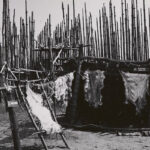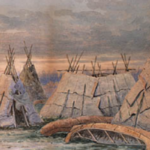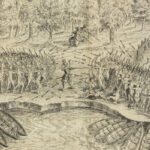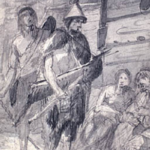Dakota Tipi First Nation: A Legacy of Dakota Strength, Diplomacy, and Renewal
The Dakota Tipi First Nation, located near Portage la Prairie, Manitoba, is part of the Dakota Oyate (Sioux Nation). The Dakota people have a rich history deeply rooted in the prairies and woodlands of North America, characterized by their adaptability, resilience, and diplomatic relationships with other Indigenous nations and settlers. The Dakota Tipi First Nation continues to play a vital role in preserving Dakota culture, language, and traditions while navigating modern challenges and opportunities.
Ancient Origins: The Dakota Oyate
The Dakota people, one of the three divisions of the Oceti Sakowin (Seven Council Fires), have lived in North America for thousands of years. Traditionally, the Dakota were semi-nomadic, moving seasonally across the Great Plains and woodlands to hunt bison, gather plants, and fish. Their way of life was deeply connected to the land, and their cultural practices reflected a balance between subsistence and spiritual reverence for the natural world.
The Dakota’s long-standing presence in the northern plains, including areas of present-day Manitoba, is supported by oral histories and archaeological evidence of settlements, tools, and sacred sites. Historian Gary Clayton Anderson, in Kinsmen of Another Kind: Dakota-White Relations in the Upper Mississippi Valley, writes, “The Dakota people’s migration and settlement patterns were shaped by their deep knowledge of the environment and their commitment to intertribal diplomacy and harmony.”
Governance and Social Structure
The Dakota people traditionally followed a governance system rooted in consensus, communal responsibility, and respect for elders. Leaders, often selected based on their ability to guide the community and mediate disputes, were expected to uphold the values of Wóhoda (respect) and Wóohoda (humility). Elders played a crucial role in passing down oral histories, spiritual teachings, and cultural knowledge to younger generations.
The Dakota Oyate were organized into Tiyospaye (extended families), which were the foundation of their social and political structures. These family units collaborated to hunt, gather, and protect their territories. Seasonal gatherings, ceremonies, and council meetings reinforced the community’s unity and cultural identity.
First Contact and Early Relationships with Settlers
The Dakota’s first sustained contact with Europeans occurred during the fur trade era in the 17th and 18th centuries. The Dakota engaged in trade with French and later British merchants, exchanging furs for goods such as firearms, metal tools, and textiles. These trade relationships, while mutually beneficial, also introduced challenges, including the overharvesting of resources and the spread of European diseases like smallpox.
In the 19th century, the Dakota faced increasing pressures from settlers encroaching on their lands in the United States. After the Dakota War of 1862, also known as the Sioux Uprising, many Dakota people fled to Canada to escape persecution by the U.S. government. The Dakota Tipi First Nation’s ancestors were among those who sought refuge in present-day Manitoba.
Historian Bruce Trigger, in Indigenous Peoples of Canada, observes, “The migration of the Dakota to Canada highlights their resilience and determination to preserve their way of life amidst profound upheaval.”
Treaty Exclusion and Land Rights in Canada
Unlike many other Indigenous nations in Canada, the Dakota were not included in the numbered treaties negotiated between the Crown and Indigenous peoples in the late 19th century. The Canadian government viewed the Dakota as “foreign” because of their migration from the United States, despite their long-standing presence in the northern plains. This exclusion left the Dakota without treaty protections, including access to land, healthcare, and education.
The Dakota Tipi First Nation was eventually granted reserve lands near Portage la Prairie, but the community faced significant challenges due to the lack of formal treaty recognition. These issues continue to shape the nation’s relationship with federal and provincial governments.
Chief Dennis Pashe, in a 2020 interview, emphasized, “The Dakota people were here long before borders divided our lands. Our history and presence in Canada must be recognized and respected.”
Cultural and Spiritual Resilience
Despite the challenges of displacement, marginalization, and systemic discrimination, the Dakota Tipi First Nation has maintained its cultural and spiritual traditions. Central to Dakota spirituality is the Sacred Pipe Ceremony, which emphasizes prayer, unity, and respect for the Creator. Ceremonies such as the Sun Dance and Wiping of the Tears remain integral to the community’s identity and healing processes.
The Dakota Tipi First Nation has also made significant efforts to revitalize the Dakota language (Dakȟótiyapi), which is a critical aspect of their heritage. Language programs, cultural workshops, and youth mentorship initiatives ensure that the next generation remains connected to their roots.
Economic Development and Self-Determination
The Dakota Tipi First Nation has taken significant steps toward economic self-sufficiency and community development. Investments in renewable energy, infrastructure, and small businesses have created jobs and opportunities for community members. These initiatives reflect the nation’s commitment to sustainability and sovereignty.
The community has also been active in advocating for their land and resource rights. Legal challenges and negotiations with federal and provincial governments aim to address historical injustices and secure a better future for the nation.
Environmental Stewardship
The Dakota Tipi First Nation has long been a steward of the land and waterways surrounding their community. Their traditional ecological knowledge informs practices in hunting, fishing, and resource management. The community has partnered with environmental organizations to protect local ecosystems and promote sustainable development.
Historian Cole Harris, in The Resettlement of British Columbia, writes, “Indigenous nations like the Dakota Tipi First Nation exemplify a deep understanding of environmental stewardship, rooted in their cultural and spiritual relationship with the land.”
Dakota Tipi First Nation Today
Today, the Dakota Tipi First Nation is a thriving community that blends traditional practices with modern governance and innovation. With a population of approximately 300 members, the community has focused on improving housing, education, and healthcare while preserving its cultural heritage.
Annual events, such as the Dakota Tipi Powwow, celebrate the community’s traditions and provide opportunities for cultural exchange and education. These events reinforce the pride and resilience of the Dakota Tipi people and their contributions to Canada’s cultural fabric.
A Legacy of Resilience and Renewal
The history of the Dakota Tipi First Nation is a testament to their resilience, adaptability, and commitment to preserving their cultural heritage. From their early migrations and diplomatic relationships to their modern efforts in economic development and cultural revitalization, the Dakota Tipi people have maintained their identity and place within Canada’s evolving landscape.
As Chief Dennis Pashe stated, “Our story is one of survival, pride, and a determination to ensure that our culture and history are never forgotten. We honour our ancestors by building a future where our people can thrive.”
References
- Anderson, Gary Clayton. Kinsmen of Another Kind: Dakota-White Relations in the Upper Mississippi Valley. University of Nebraska Press, 1984.
- Carter, Sarah. Lost Harvests: Prairie Indian Reserve Farmers and Government Policy. McGill-Queen’s University Press, 1990.
- Conrad, Margaret. A Concise History of Canada. Cambridge University Press, 2012.
- Fisher, Robin. Contact and Conflict: Indian-European Relations in British Columbia. UBC Press, 1997.
- Ignace, Marianne and Ronald E. Ignace. Keeping the Stories Alive: Language, Land, and Culture in Indigenous Communities. University of Toronto Press, 2008.
- Trigger, Bruce G. Indigenous Peoples of Canada. McGill-Queen’s University Press, 1992.
- Dakota Tipi First Nation. Guardians of the Plains: The History and Culture of Dakota Tipi First Nation. Dakota Tipi Publications, 2015.
- Pashe, Dennis. “Reclaiming Our Rights: The Future of Dakota Tipi.” CBC News, 2020.
- Treaty Elders of Manitoba. The Dakota Perspective: Oral Histories and Reflections. University of Manitoba Press, 2005.
- Ridington, Robin. Trail to Heaven: Knowledge and Narrative in a Northern Native Community. Douglas & McIntyre, 1988.



